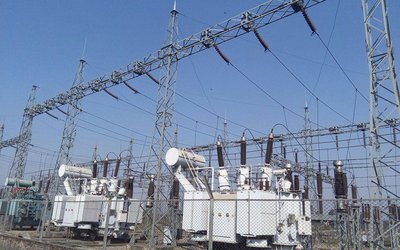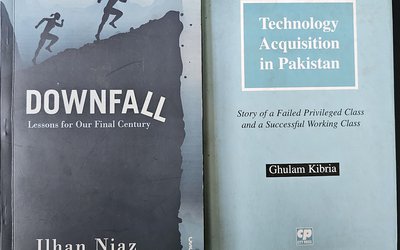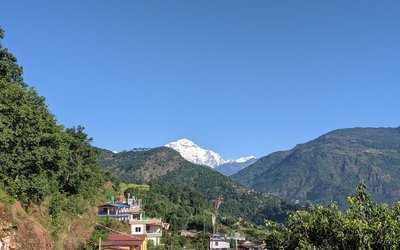I recently got an opportunity to visit Ghorahi in Dang and Birendranagar in Surkhet after a gap of almost three and two decades respectively. While I had passed through Deukhuri valley many times in between, I had not returned to these towns in the meanwhile. This time gap allowed me to reflect on the dramatic changes that have transpired there as well as the dynamic drivers behind them, which are also at work all over Nepal and with which Kathmandu’s Loktantrick political leadership seems so out of touch. Physically, the changes in these erstwhile sleepy townships are dramatic: if I had been blindfolded and brought here, on opening my eyes I would not be able to tell if I was in Itahari or Narayanghat or Gwarko in Lalitpur for that matter.
Nothing illustrated this disjuncture between physical growth and the lack of a moral compass better than the Samadhi of Mauni Baba, a saint whose ashram was just north of Ghorahi above a small, natural lake called Barha Kune Daha. He was famous for his penance of giving up speech (‘maun’) and wrote his spiritual advice to visitors with a piece of chalk on a black slate. He is long gone and today only a handful of old jogi disciples live in the simple kutis that the Maoists had at one time desecrated during their cultural war on tradition. The Daha below has been face-lifted with cement, new temples have been built, and because it is adjacent to the highway that runs from Ghorahi to Holeri in Rolpa it has become a kind of ‘picnic spot’ for young lovers of all hues. (The highway itself, I was told, is incomplete in Rolpa because the contractor just could not continue work with rampant extortion by political party thugs and rent-seeking officials.) The spiritual solace that the gentle monk who lived here provided, however, is absent and is symbolic of Ghorahi’s physical beautification bereft of a moral goal that the rest of Nepal too seems to be experiencing.
These two towns were the entrepot for their hinterlands of Pyuthan, Rolpa, Jajarkot and Dailekh but had been unable to either grow themselves or provide better services to the inner districts in those years, primarily because entrenched local feudalism and because a Panchayat polity that pandered to it was happy within the limited rent-seeking it could effect without upsetting its feudal production based of corvee labour. What the 1990 revolution did was to unleash the latent market alternatives. However, in the absence of guidance from a far-sighted nationalist polity at the center (and concurrently at the district level), these alternative forces took to the path of least resistance and invested their savings in poorly regulated real estate, as well as outward forms of education without substantive quality and health care that is a misnomer for Indian pharmaceutical company penetration.
Investment in productive enterprises as the South-East Asians or the Chinese have managed is missing because there was no visionary statesmanship coming from the new political masters of Loktantra, no guidance about the productive sectors where Nepali savings could have been invested. Instead both the Maoist rebels and the rent-seeking parliamentary parties chose to destroy nascent productive industries of Nepal (even the little begun by the reluctant Panchayat), the former by bombing and the latter by unbridled trade unionism demands as well as blind privatization. The result was that Nepali young labour force could not find productive employment within Nepal and had to join the global proletariat in the Gulf, Malaysia or Korea. Their remittances is what has driven the physical infrastructure boom in towns like Gorahi and Surkhet, both directly from family investments in housing and indirectly from increased government revenues that comes from indirect import and vat taxes. These two towns also saw increased in-migration from surrounding hinterlands made insecure by the Maoist insurgency; but after the ‘defanging’ of the Maoists in 2010, many ex-combatants have not returned to their villages but chosen these two towns to settle and run assorted businesses, some such as bakeries being quite popular.
This new social phenomenon, not captured by either classical Marxism or neo-liberal economics, is best captured by a new approach in understanding rural-urban interlinkage called desakota from Bahasa Indonesia term that means neither village nor town or both. It describes vast swathes of the geographic spectrum between the two vanishing ends of purely rural and purely urban where the income basket of families may constitute 40 or less percent from rural sources and 60 or more percent from urban earnings, the urban in Nepal’s case being as far away as the Gulf, Korea or even cities in Europe and America. With such a mixture of income sources comes a concomitant ‘neither urban nor rural’ admixture of consumer behaviour where traditional rural institutional values of obligations are overtaken by short-term market individualism but modern urban regulations have no effective reach.
Traditional politics of liberalism or socialism or Marxism completely fail to anticipate such changes on behaviour and hence find themselves helpless bystanders. This essay is being completed in Nepalganj after some of us went to the Bheri Technical School’s premises where prime minister Sushil Koirala made a sadly slurred and insipid speech at the gathering organized to collect suggestions for improving the draft constitution. The public, on the other hand, seems more attracted to listening to RPP-N’s Hindu nation campaign, the women activists with their ‘and’ versus ‘either’ debate on citizenship and the Tarai bandh called by disgruntled Madhesh parties demanding that federalism not be pushed under the carpet. Neither the big party oligarchs supposedly framing the governance structure for this new emerging order nor the traditional Bretton Woods birthed donor agencies seem to be aware, or capable of guiding, this new political economy. Both seem to have nothing but yesterday’s development jargons and slogans of a stale political economic philosophy.
Even less do they seem to understand the roiling of disgruntlement at the local level in the absence of local self-government for over a decade. In its absence, the parties have failed to nurture a new cadre of younger leadership and the donors have ended up funding structured corruption. The VDC secretaries in roughly four thousand VDS of Nepal and the 75 LDOs in the districts are now legally under the interregnum arrangements that have dragged on and on with no sign of political commitment to end them any time soon, arrangements that make them simultaneously both the chief civil servants and their own political bosses. The LDO is today more powerful than the CDO because he is also the officiating DDC chair and thus the political boss of the CDO and the person with all the resources as all donors and INGOs have to report to him for permission. The same has happened with the VDC chair, making both these positions all over Nepal as autocratic and unaccountable as Girija Koirala when he functioned in Loktantra as both the king and his prime minister!
To expect a self-correcting statesmanship from this set of political oligarchs – and the drafting of a new and coherent constitution that re-frames Nepal’s governance system to reflect the country new desakota realities – is a dream too far.

Dipak Gyawali
Gyawali is Pragya (Academician) of the Nepal Academy of Science and Technology (NAST) and former minister of water resources.
- Maldevelopment And Technology: Ethos Harbingering Coming Apocalypse
- Apr 03, 2024
- World Social Forum: Rethinking and Redefining Development Itself
- Feb 21, 2024
- Remembering An Inspiring Karma Yogi
- Jan 09, 2024
- New World Disorder And The Case For Ideology
- Dec 13, 2023
- Loktantra’s Moral Turpitude
- Nov 06, 2023















